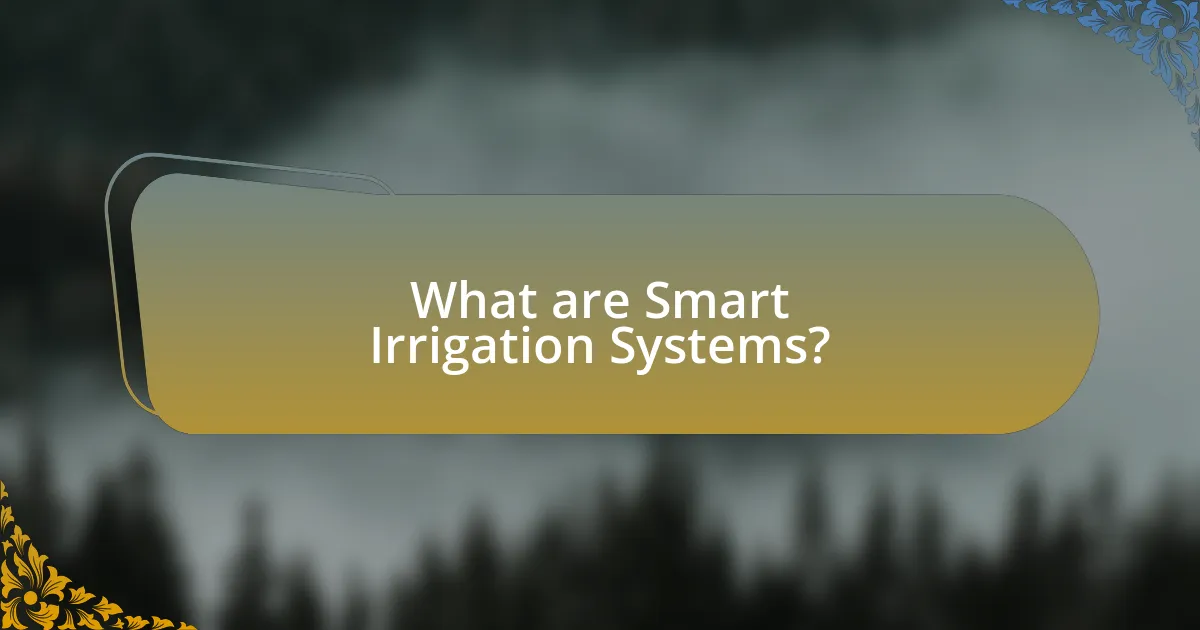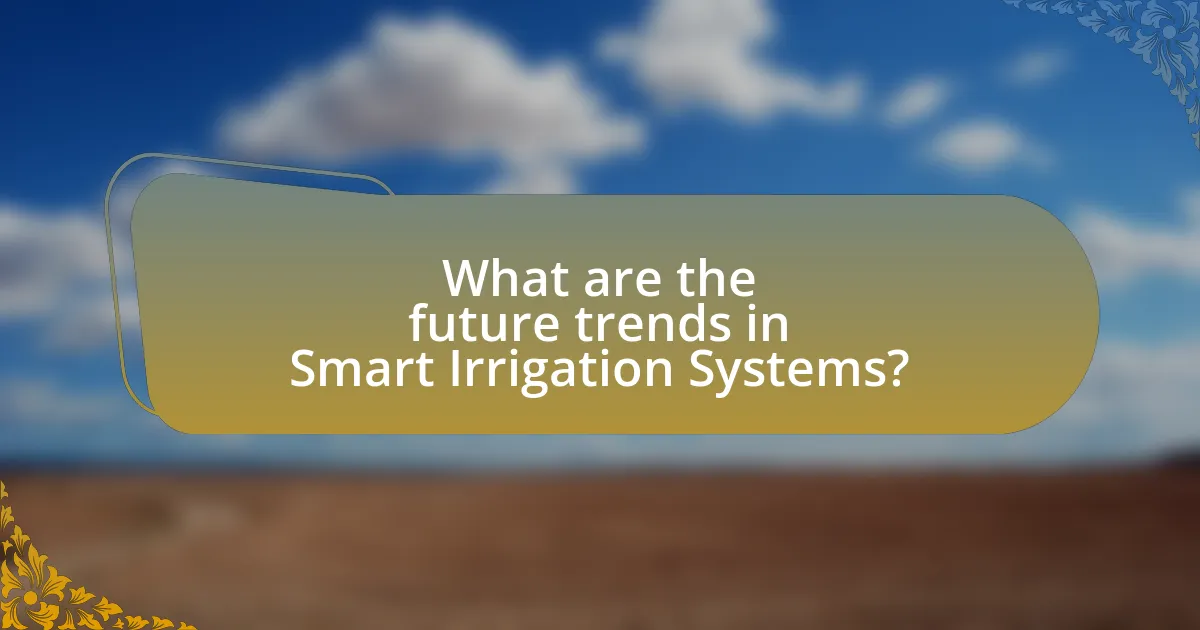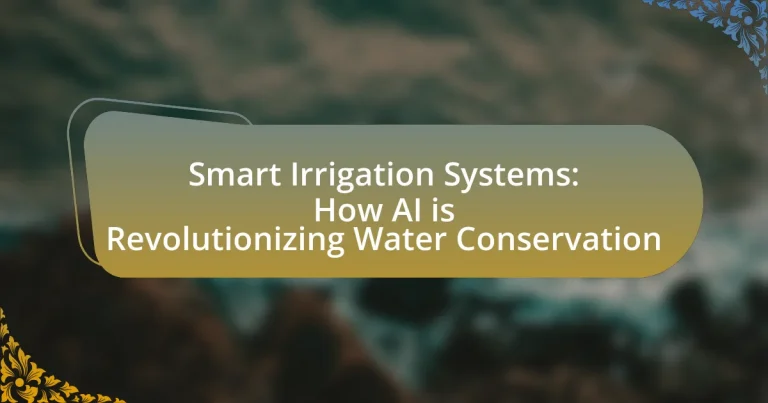Smart irrigation systems are advanced technologies that optimize water usage in agriculture and landscaping by utilizing sensors, weather data, and automated controls. These systems significantly reduce water waste, with studies indicating potential reductions in water consumption by up to 50% compared to traditional methods. The article explores the functioning of smart irrigation systems, the integration of AI and various technologies, their environmental and economic benefits, and the challenges faced by farmers in adopting these systems. Additionally, it discusses future trends and best practices for maintaining smart irrigation systems, highlighting their crucial role in promoting sustainable agriculture and combating climate change.

What are Smart Irrigation Systems?
Smart irrigation systems are advanced technologies designed to optimize water usage in agricultural and landscaping applications. These systems utilize sensors, weather data, and automated controls to determine the precise amount of water needed for plants, significantly reducing water waste. According to a study by the University of California, smart irrigation can reduce water usage by up to 50% compared to traditional methods, demonstrating their effectiveness in promoting water conservation.
How do Smart Irrigation Systems function?
Smart irrigation systems function by utilizing sensors, weather data, and algorithms to optimize water usage for irrigation. These systems monitor soil moisture levels, weather conditions, and plant water requirements to determine the precise amount of water needed, thereby reducing waste and ensuring efficient irrigation. For instance, a study by the University of California found that smart irrigation systems can reduce water usage by up to 30% compared to traditional methods, demonstrating their effectiveness in conserving water resources.
What technologies are integrated into Smart Irrigation Systems?
Smart Irrigation Systems integrate various technologies such as soil moisture sensors, weather data analytics, and automated control systems. Soil moisture sensors measure the water content in the soil, enabling precise irrigation based on actual needs rather than schedules. Weather data analytics utilize real-time meteorological information to adjust irrigation schedules, preventing overwatering during rainfall. Automated control systems allow for remote management and adjustments, enhancing efficiency and reducing water waste. These technologies collectively contribute to optimized water usage and improved crop health, demonstrating the effectiveness of smart irrigation in water conservation efforts.
How do sensors contribute to the efficiency of Smart Irrigation Systems?
Sensors enhance the efficiency of Smart Irrigation Systems by providing real-time data on soil moisture, temperature, and weather conditions. This data allows the system to optimize water usage by delivering precise amounts of water only when necessary, reducing waste and promoting healthier plant growth. For instance, studies have shown that using soil moisture sensors can decrease water consumption by up to 30% compared to traditional irrigation methods. By integrating this technology, Smart Irrigation Systems can significantly improve water conservation efforts while maintaining agricultural productivity.
What role does AI play in Smart Irrigation Systems?
AI plays a crucial role in Smart Irrigation Systems by optimizing water usage through data analysis and predictive modeling. These systems utilize AI algorithms to process real-time data from soil moisture sensors, weather forecasts, and plant health indicators, enabling precise irrigation scheduling. For instance, a study published in the journal “Agricultural Water Management” found that AI-driven irrigation systems can reduce water consumption by up to 30% while maintaining crop yields. This efficiency not only conserves water but also enhances agricultural productivity, demonstrating the significant impact of AI on sustainable farming practices.
How does AI optimize water usage in irrigation?
AI optimizes water usage in irrigation by utilizing data analytics, machine learning, and sensor technology to make real-time decisions about water application. These systems analyze various factors such as soil moisture levels, weather forecasts, and crop water requirements to determine the precise amount of water needed at any given time. For instance, a study published in the journal “Agricultural Water Management” found that AI-driven irrigation systems can reduce water usage by up to 30% while maintaining crop yields. This efficiency is achieved through targeted irrigation, which minimizes waste and ensures that plants receive the optimal amount of water for growth.
What algorithms are commonly used in AI-driven irrigation systems?
Common algorithms used in AI-driven irrigation systems include decision trees, support vector machines, and neural networks. Decision trees help in making irrigation decisions based on environmental data, while support vector machines classify soil moisture levels to optimize water usage. Neural networks analyze complex patterns in data, such as weather forecasts and soil conditions, to predict irrigation needs accurately. These algorithms enhance water conservation by enabling precise and efficient irrigation management, ultimately leading to reduced water waste and improved crop yields.
What are the environmental benefits of Smart Irrigation Systems?
Smart Irrigation Systems significantly reduce water usage, leading to enhanced water conservation and decreased environmental strain. These systems utilize advanced technologies such as soil moisture sensors and weather data to optimize irrigation schedules, ensuring that water is applied only when necessary. Research indicates that implementing smart irrigation can reduce water consumption by up to 50%, which helps preserve local water resources and maintain ecosystem balance. Additionally, by minimizing overwatering, these systems prevent runoff and reduce the risk of soil erosion and nutrient leaching, further protecting water quality in surrounding areas.
How do Smart Irrigation Systems contribute to water conservation?
Smart Irrigation Systems contribute to water conservation by utilizing advanced technology to optimize water usage based on real-time data. These systems employ sensors and weather forecasts to determine the precise amount of water needed for irrigation, significantly reducing waste. For instance, studies have shown that smart irrigation can reduce water consumption by up to 50% compared to traditional methods, as they only irrigate when necessary and adjust for environmental conditions. This efficiency not only conserves water but also promotes healthier plant growth by preventing overwatering and ensuring that plants receive the right amount of moisture.
What impact do Smart Irrigation Systems have on soil health?
Smart Irrigation Systems positively impact soil health by optimizing water usage and reducing soil erosion. These systems utilize sensors and data analytics to deliver precise amounts of water, which helps maintain optimal moisture levels in the soil. Research indicates that maintaining appropriate moisture levels enhances microbial activity and nutrient availability, crucial for soil fertility. Additionally, by minimizing overwatering, Smart Irrigation Systems prevent nutrient leaching and soil degradation, thereby promoting a healthier soil ecosystem.
How are Smart Irrigation Systems implemented in agriculture?
Smart Irrigation Systems are implemented in agriculture through the integration of sensors, weather data, and automated controls to optimize water usage. These systems utilize soil moisture sensors to monitor the water content in the soil, allowing for precise irrigation scheduling based on real-time data. Additionally, weather forecasts are incorporated to adjust irrigation practices according to rainfall predictions, reducing water waste. Research indicates that farms using smart irrigation can achieve water savings of up to 30% while maintaining crop yields, demonstrating the effectiveness of these systems in enhancing water conservation efforts.
What challenges do farmers face when adopting Smart Irrigation Systems?
Farmers face several challenges when adopting Smart Irrigation Systems, including high initial costs, technical complexity, and the need for reliable internet connectivity. The initial investment for smart irrigation technology can be prohibitive, with costs for equipment and installation often exceeding thousands of dollars. Additionally, the technical complexity of these systems requires farmers to have a certain level of expertise or training, which may not be readily available. Furthermore, many smart irrigation systems rely on internet connectivity to function effectively; in rural areas, this can be inconsistent or unavailable, hindering the system’s performance. These challenges can significantly impede the widespread adoption of smart irrigation technologies among farmers.

What are the economic advantages of Smart Irrigation Systems?
Smart Irrigation Systems provide significant economic advantages by optimizing water usage, which leads to reduced operational costs for farmers and agricultural businesses. These systems utilize advanced technologies, such as sensors and AI algorithms, to monitor soil moisture levels and weather conditions, ensuring that water is applied only when necessary. This precision reduces water waste and lowers utility bills, with studies indicating that smart irrigation can decrease water usage by up to 30-50%. Additionally, the increased efficiency can enhance crop yields, leading to higher revenues. For instance, a report from the USDA found that implementing smart irrigation technologies can result in a return on investment of up to 300% over several years, demonstrating the financial benefits of adopting these systems.
How do Smart Irrigation Systems reduce operational costs?
Smart Irrigation Systems reduce operational costs by optimizing water usage through real-time data analysis and automated scheduling. These systems utilize sensors and weather data to determine the precise amount of water needed for irrigation, minimizing waste and ensuring that plants receive only what they require. Research indicates that implementing smart irrigation can lead to water savings of 20-50%, which directly translates to lower water bills and reduced energy costs associated with pumping and distributing water. Additionally, the automation of irrigation processes decreases labor costs, as less manual intervention is needed to manage watering schedules.
What is the return on investment for farmers using Smart Irrigation Systems?
Farmers using Smart Irrigation Systems can expect a return on investment (ROI) of approximately 20% to 50% annually. This ROI is achieved through increased crop yields, reduced water usage, and lower labor costs. For instance, a study by the University of California found that implementing smart irrigation technology can lead to water savings of up to 30%, which directly translates into cost savings for farmers. Additionally, the improved efficiency of water application enhances crop health and productivity, further contributing to financial gains.
What funding options are available for implementing Smart Irrigation Systems?
Funding options for implementing Smart Irrigation Systems include government grants, low-interest loans, and private investments. Government programs, such as the USDA’s Environmental Quality Incentives Program (EQIP), provide financial assistance to farmers adopting advanced irrigation technologies. Additionally, state and local water conservation programs often offer rebates or incentives for smart irrigation installations. Private investors and venture capital firms are increasingly funding innovative agricultural technologies, including smart irrigation solutions, to promote sustainable practices. These funding avenues support the transition to efficient water management systems, crucial for enhancing water conservation efforts.
How can government incentives support the adoption of Smart Irrigation Systems?
Government incentives can significantly support the adoption of Smart Irrigation Systems by providing financial assistance, tax breaks, and grants to farmers and landowners. These incentives lower the initial investment costs associated with purchasing and installing advanced irrigation technologies, making them more accessible. For instance, programs like the USDA’s Environmental Quality Incentives Program (EQIP) offer cost-sharing for implementing water-saving practices, which has led to increased adoption rates of smart irrigation solutions. Additionally, research indicates that states with robust incentive programs see a higher percentage of farmers adopting these technologies, thereby enhancing water conservation efforts and improving agricultural efficiency.

What are the future trends in Smart Irrigation Systems?
Future trends in Smart Irrigation Systems include the integration of artificial intelligence, real-time data analytics, and IoT connectivity. These advancements enable systems to optimize water usage by analyzing weather patterns, soil moisture levels, and plant health. For instance, AI algorithms can predict irrigation needs based on historical data and current environmental conditions, leading to more efficient water conservation. Additionally, the adoption of sensor technology and automated systems is expected to increase, allowing for precise irrigation scheduling and reducing water waste. According to a report by MarketsandMarkets, the smart irrigation market is projected to grow from $1.5 billion in 2020 to $2.8 billion by 2025, highlighting the rising demand for these innovative solutions.
How is technology evolving in Smart Irrigation Systems?
Technology in Smart Irrigation Systems is evolving through the integration of artificial intelligence, IoT sensors, and data analytics. These advancements enable real-time monitoring of soil moisture levels, weather conditions, and plant health, allowing for precise water application tailored to specific needs. For instance, AI algorithms analyze historical data and current environmental factors to optimize irrigation schedules, significantly reducing water waste. According to a study by the University of California, implementing smart irrigation technologies can lead to water savings of up to 30% compared to traditional methods. This evolution not only enhances water conservation but also promotes sustainable agricultural practices.
What advancements in AI are expected to enhance Smart Irrigation Systems?
Advancements in AI expected to enhance Smart Irrigation Systems include improved predictive analytics, real-time data processing, and machine learning algorithms. Predictive analytics will enable systems to forecast weather patterns and soil moisture levels more accurately, allowing for optimized water usage. Real-time data processing will facilitate immediate adjustments based on environmental changes, ensuring efficient irrigation schedules. Machine learning algorithms will analyze historical data to identify patterns and improve decision-making processes, leading to more sustainable water management practices. These advancements are supported by studies showing that AI-driven irrigation can reduce water usage by up to 30% while maintaining crop yields.
What role do Smart Irrigation Systems play in sustainable agriculture?
Smart Irrigation Systems play a crucial role in sustainable agriculture by optimizing water usage and enhancing crop yield. These systems utilize advanced technologies such as sensors, weather data, and AI algorithms to deliver precise amounts of water based on real-time conditions, significantly reducing water waste. For instance, a study by the University of California found that smart irrigation can reduce water consumption by up to 50% while maintaining crop productivity. This efficiency not only conserves water resources but also minimizes the environmental impact of agriculture, making it a key component in promoting sustainability in farming practices.
How can Smart Irrigation Systems help combat climate change?
Smart Irrigation Systems can help combat climate change by optimizing water usage, thereby reducing water waste and lowering greenhouse gas emissions associated with water management. These systems utilize advanced technologies such as sensors, weather data, and AI algorithms to deliver precise amounts of water to crops based on real-time conditions. For instance, a study by the University of California found that smart irrigation can reduce water consumption by up to 50%, which not only conserves water resources but also minimizes the energy required for water pumping and distribution, further decreasing carbon emissions.
What are best practices for maintaining Smart Irrigation Systems?
Best practices for maintaining Smart Irrigation Systems include regular system checks, software updates, and sensor calibration. Regular system checks ensure that all components, such as valves and pumps, are functioning correctly, which is crucial for optimal performance. Software updates are necessary to incorporate the latest features and improvements, enhancing system efficiency and reliability. Sensor calibration is essential to ensure accurate readings of soil moisture and weather conditions, which directly impacts irrigation scheduling and water conservation efforts. These practices collectively contribute to the effective operation of Smart Irrigation Systems, ultimately supporting water conservation goals.


